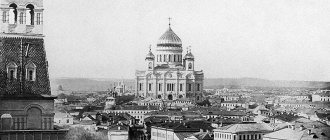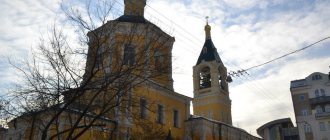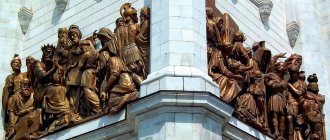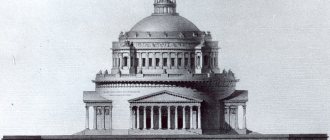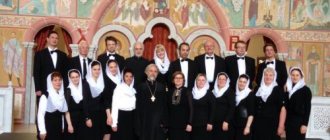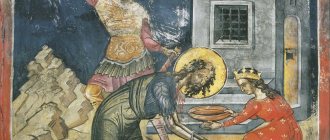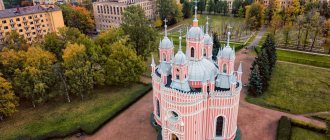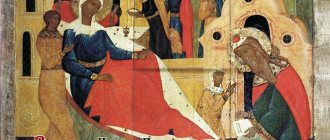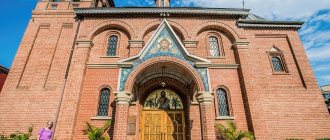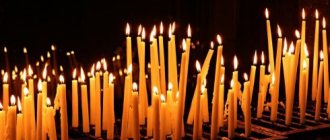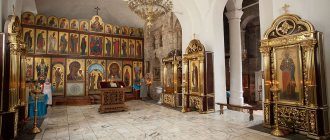| Honest head of St. Forerunner and Baptist of the Lord John. Icon |
The Honest Head of the Prophet and Forerunner of the Lord John,
Holy Tradition tells us that after the beheading of the honest head of St. John the Baptist, the wicked Herodias did not allow her to be buried along with the body of the saint, but, having violated her, buried her in her palace in a “dishonorable place.” The saint’s disciples secretly took the body and buried it. The pious Joanna, the wife of the royal steward Chuza (the holy evangelist Luke mentions her - Luke 8:3) knew where Herodias buried the honest head. And she secretly took the holy head, put it in a vessel and buried it on the Mount of Olives - in one of Herod’s estates.
When rumors about Jesus' preaching and the miracles he performed reached the royal palace, Herod and his wife Herodias went to check whether the head of John the Baptist was still there. Not finding her, they began to think that Jesus Christ is the risen John the Baptist. The Gospel also testifies to this error of theirs (Matthew 14:2).
First discovery of the head of John the Baptist
Memory 24 February.
After many years, this estate came into the possession of the pious nobleman Innocent, who began to build a church there. When they were digging a ditch for the foundation, a vessel with the honest head of John the Baptist was found. Innocent learned about the greatness of the shrine from the signs of grace that came from it. This is how the First Finding of the Head took place. Innocent kept it with the greatest reverence, but before his death, fearing that the shrine would be desecrated by infidels, he again hid it in the very place where he found it. After his death, the church fell into disrepair and collapsed.
This was the second discovery.
The third discovery occurred already in the 9th century, after the Christians of Constantinople hid it from the raids of the Saracens. The head was discovered by Patriarch Ignatius. In a dream, God revealed to him the place where the shrine was hidden. This was the city of Komani, now located in Turkey. The day of her discovery and return to Constantinople became a holiday.
There are several versions of where John’s head is now. Catholics believe that she is in the Church of San Silvestro in Rome. Muslims claim that the shrine is in Damascus, in the Umayyad mosque. The Armenian version says that the head is in the monastery of Nagorno-Karabakh, and the Greek version says that it is on Mount Athos. Perhaps these places belong only to parts of the Christian shrine.
More details on All Iskitim: https://vesiskitim.ru/2021/05/20/209345-7-iyunya-prazdnovanie-v-chest-tretego-obreteniya-glavy-predtechi-i-krestitelya-gospodnya-ioanna
Second discovery of the head of John the Baptist
Memory 24 February.
Many years later, during the reign of Equal-to-the-Apostles Tsar Constantine, his mother Saint Helena restored the Jerusalem shrines. Many pilgrims began to flock to the Holy Land, among whom two monks from the East came to venerate the Holy Cross and the Holy Sepulcher. St. entrusted them with John the Baptist to find his honorable head. We only know that this was revealed to them in a dream and that after finding an honest head in the place indicated by him, they decided to return back. However, God's will was different. On the way, they met a poor potter from the Syrian city of Emesa (now Homs), who was forced due to poverty to go in search of work in a neighboring country. The monks, having found a traveling companion, out of negligence or laziness, entrusted him with carrying the bag with the shrine. And he carried it to himself until Saint John the Baptist appeared to him and commanded him to leave the careless monks and flee from them along with the bag entrusted to him by Providence himself.
The Lord, for the sake of the head of John the Baptist, blessed the potter's house with all sufficiency. The potter lived his entire life, remembering what he owed and to whom, he was not proud and gave alms abundantly, and shortly before his death he handed over the honest head to his sister, commanding him to pass it on to God-fearing and virtuous Christians.
However, according to the Providence of God, the honest head, passing for a long time from one person to another, fell into the hands of Hieromonk Eustathius, infected with the heresy of Arius. Sick people who came to him received healing from him, not knowing that the reason for this was not the latter’s imaginary piety, but the grace emanating from his hidden head. Soon his wickedness was revealed, and he was expelled from Emesa. And around the cave where the hieromonk lived and in which the head of John the Baptist was buried, a monastery was formed.
After much time, by the grace of God, the second acquisition of an honest head took place. We know this for certain from the description of both the Archimandrite of the Emes monastery Markell himself, and from the life of the Venerable Matrona (November 9), written by St. Simeon Metaphrastus. According to the legend of the first, the honest chapter was revealed to him on February 18, 452. A week later, Bishop Uranius of Emesa opened her veneration, and on February 26 of the same year she was transferred to Emesa to the newly created church in the name of John the Baptist. All these events were accompanied by both the healing of the sick and the miraculous revelation of the unbelief of some clergy.
After some time, the honest head of St. Joanna was transferred to Constantinople, where she remained until the reign of the iconoclastic heresy. Pious Christians, leaving Constantinople, secretly took with them the head of John the Baptist and hid it in Comana (it is not known which Comana we are talking about - Cappadocian or Pontic).
What to pray for and how does the Holy Image help?
On this day, you should definitely read prayers to the saint, which help in various life situations. They ask him about:
- getting rid of illnesses and headaches.
- if you are confused on the path of life and are looking for tips on what to do next. It also helps you get out of a difficult situation.
By praying to John the Baptist, many people have the feeling that they are getting rid of a large burden on their souls. For this reason, people turn to the saint on other occasions:
- asking for relief from bad habits.
- pray for the joy of healthy motherhood.
- They pray for strengthening in faith and guidance on the right path.
In each of the churches there are icons of St. John the Saint. For this reason, parishioners often turn to him. It is believed that the icon of John the Baptist helps every person to successfully cope with any work and fulfill their duty with dignity.
The Third Discovery of the Head of John the Baptist
Memory May 25
After the restoration of icon veneration at the Council of Constantinople in 843, the venerable head was returned to the Byzantine capital around 850. The Church celebrates this event on May 25 as the third finding of the head of St. John the Baptist.
After 850, part of the honest chapter ended up in Petra in the Prodromus monastery, and the other part in the Studian Baptist Monastery, from where in 1204 it was transferred by the crusaders to Amiens in northern France. In addition, the footnote indicates three other locations of particles of the venerable head: the Athos Dionysian Monastery, the Ugrovlahia monastery of Kalui and the Church of Pope Sylvester in Rome, to which a particle of the relics was transferred from Amiens. According to Armenian legend, the honest head of the Forerunner (or rather, part of it) during one of the crusades was brought from Cilician Armenia to modern Nagorno-Karabakh, where she was buried in the tomb of the temple of the Gandzasar monastery.
| Head of John the Baptist, kept in Amiens (France) |
Studio particle
After 850, part of the venerable head of the Forerunner was found in the Studii Forerunner Monastery. In this monastery, the top of the dome was seen by the pilgrim Anthony back in 1200.
On April 14, 1204, during the IV Crusade, the crusaders captured Constantinople. The city was devastated and plundered. As Western legend says, Canon Wallon de Sarton from Picquigny found a case containing a silver dish in the ruins of one of the palaces. On it, under a glass cover, the remains of a human face were hidden, only the lower jaw was missing. A small hole was visible above the left eyebrow, probably made by a blow from a dagger.
On the dish, the canon discovered an inscription in Greek, confirming that he was the owner of the relics of St. John the Baptist. In addition, the presence of a hole above the eyebrow was consistent with the event mentioned by St. Jerome. According to his testimony, Herodias, in a fit of anger, struck the severed head of St. with a dagger. John.
Vallon de Sarton decided to deliver the head of St. John the Baptist to Picardy, northern France.
On December 17, 1206, on the third Sunday of Nativity Lent, Bishop of Amiens Richard of Gerberoy solemnly met the head of St. John the Baptist at the entrance to Amiens. Probably, the bishop was confident of the authenticity of the relics, which was easier to verify then, as they say, “without delay.” From this time the veneration of the head of St. begins. John in Amiens and throughout Picardy.
In 1220, the Bishop of Amiens laid the first stone in the foundation of the new cathedral, which, after many additions, would in the future become the most magnificent Gothic building in Europe.
Its main shrine was also transferred to this cathedral: the front part of the venerable head of St. John.
Gradually, Amiens becomes a place of pilgrimage not only for ordinary Christians, but also for French kings, princes and princesses. The first to come to venerate the venerable head was Saint Louis, King of France, in 1264. Then his son came - Philip III the Bold, Charles VI and Charles VII, who made large offerings to decorate the relics.
In 1604, Pope Clement VIII, wanting to enrich the Baptist Church in Rome (Basilica di San Giovanni in Laterano), asked the canons of Amiens for a particle of the relics of St. John.
After the revolution of 1789, inventories of church property and seizures of relics took place throughout France.
Reliquary of the Venerable Head of St. John the Baptist remained in the cathedral until November 1793, when it was requested by representatives of the Convention. They removed all the jewelry from the relics, and ordered the honest head to be sent to the cemetery. But the will of the high authorities was not fulfilled. After their departure, the mayor of the city, Louis-Alexandre Lescouve, secretly returned to the treasury and took the relics to his house. Thus this shrine was preserved. A few years later, the former mayor handed it over to Abbot Lejeune for safekeeping. In 1816, the head of St. Joanna was returned to the cathedral.
At the end of the 19th century, historical science, not without the participation of church leaders, recognized that in the Middle Ages there were many cases of forgery of relics. Due to general mistrust, veneration of the Amiens shrine began to gradually fade away.
A new surge of interest in the relics occurred in the middle of the century, namely in 1958. The rector of Amiens Cathedral informed the church authorities that in the east of France in Verdun, since the 17th century, a lower jaw, presumably of St. John the Baptist. He wanted to make a comparison of the two parts. With the blessing of the Bishop of Amiens, a commission of qualified medical experts was established.
The study of the relics lasted for several months and took place in two stages: the first in Amiens, the second in Paris. Upon completion of the work, the commission's findings were collected in a document signed by all its members.
Based on the first chapter of the document, which is devoted to research carried out in Amiens, the following conclusions were drawn:
- A comparison of the object called Verdun with the object from Amiens revealed their anatomical incompatibility, which undoubtedly confirms their different origins.
- From a chronological point of view, the object called Verdun is less ancient than the Amiens one. In its appearance and weight it resembles the “bones of the Middle Ages.”
- The front part, called the head of St. John the Baptist from Amiens, is a very ancient object - more ancient than the “bones of the Middle Ages”. On the other hand, it appears to be less ancient than Mesolithic human bones, which allows its age to be dated between 1000 and 2500 years.
- The person's age cannot be determined due to missing teeth. But based on the fact that the alveoli (tooth sockets) are fully developed and that some at the edges are slightly worn away, we can assume that we are talking about an adult (between 25-40 years).
- The general characteristics of the head due to the lack of elements can be determined, but with a larger tolerance. The type of face is Caucasoid (which means neither Negroid nor Mongoloid). The small size of the Amiens object and the development of the lower ocular arches lead to the assumption that it might correspond to a racial type called “Mediterranean” (the type to which modern Bedouins belong).
Life and Death of John
John was born exactly six months before Jesus, in the family of the Jewish priest Zechariah. His wife Elizabeth was related to the Virgin Mary. The elderly couple had no children, which was considered a punishment from above. God's miracle helped me conceive and give birth to a son.
As a young man, John withdrew into the desert, where he prayed intensely. Animal skins served him as clothing, and wild honey, locusts and carob fruits served as food. When John was about 30, he heard the voice of God. The prophet went to tell the Jews about the coming of the Savior and call them to repentance.
John baptized the Son of God and many people in the Jordan. He was later arrested for accusing Herod Antipas, a local ruler. He married Herodias, taking her away from his brother.
When Herod received guests, Herodias' daughter Salome amazed them with a beautiful dance. For this, Herod promised to give her whatever she asked for. The embarrassed girl consulted with her mother. Herodias hated John so much that she ordered Salome to demand his head. Herod was horrified, but fulfilled the request. The head of John was brought to the girl and her mother on a silver platter.
Prayer to John the Baptist on Memorial Day June 7
Baptist of Christ, preacher of repentance, do not despise me who repents, but, copulating with the heavenly ones, pray to the Lady for me, unworthy, sad, weak and sad, fallen into many troubles, burdened by the stormy thoughts of my mind. Because I am a den of evil deeds, with no end to sinful customs, my mind is nailed down by earthly things. What I will do, we do not know, and to whom I will resort, so that my soul will be saved, only to you, Saint John, by your namesake of grace, for you are before the Lord, according to the Theotokos, greater than all who were born: for you were deemed worthy to touch the heights of King Christ, take away the sins of the world, the Lamb of God. Pray to Him for my sinful soul, so that from now on, at the first ten hour, I will bear a good burden and accept recompense with the last. To her, the Baptist of Christ, the honest Forerunner, the ultimate prophet, the first martyr in grace, the teacher of fasters and hermits, the teacher of purity and the neighbor of Christ, I pray to you, I resort to you, do not reject me from your intercession, but raise me up, having fallen into many sins, renew my soul with repentance, as with the second baptism, since you are the ruler of both, wash away sin with baptism, and preach repentance for the cleansing of every bad deed; Cleanse me, defiled by my sins, and force me to enter, even if nothing bad enters, into the Kingdom of Heaven, Amen.
